originally posted at https://canmom.tumblr.com/post/162596...
Last time, the entire cast died! And we entered a tea party in Purgatory wherein the characters are dispassionately discussing the plot of the novel.
Battler still holds that no supernatural forces were involved. The other characters challenge him to explain the various awful goings-on.
-
crime: destroying faces in the rose garden shed
- explanation: they could used one of the electric tools in the shed.
-
crime: making Kinzo leave his study, even though it was locked
- explanation: as discussed in the story, Kinzo might have hidden and snuck out behind Natsuhi and Eva, or left via the window and Natsuhi closed it behind him.
- crime: killing Hideyoshi and Eva
- explanation: using ‘some device’ to attack through the crack in the door, and appealing to the writers of locked-room mysteries coming up with other possibilities
- I don’t think that’s very satisfying, so here’s an alternative: the culprit could have been hiding in the room when Hideyoshi and Eva entered, murdered them, and stayed hidden during the subsequent investigation. Then, once the other characters departed, they could have left using the master key because the chain had been broken.
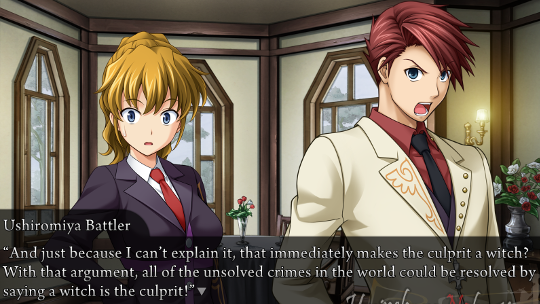
Battler essentially argues that because ‘magic’ is a fully general-purpose explanation, it actually explains nothing at all. Not all that far from Popperian falsifiability.
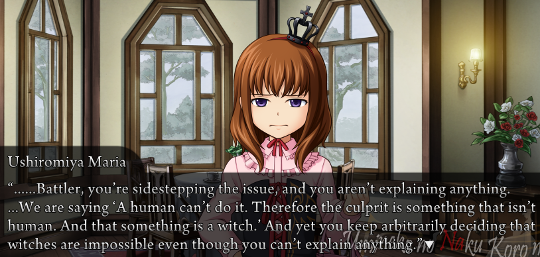
Maria suggests he’s arbitrarily excluding a class of explanations rather than responding to evidence.
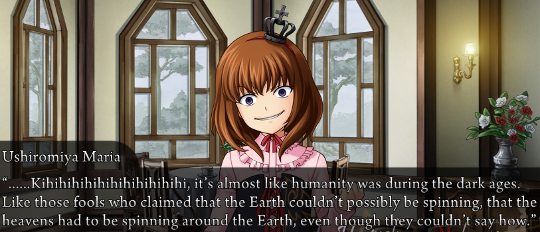
Maria’s appeal to the history of science is somewhat flawed. Early forms of heliocentricity were by no means empirically superior to geocentric models with epicycles, even if at the time people followed this kind of understanding of inference. Galileo, for example, argued tides were ‘sloshing about’ of water due to the motion of the Earth, which we wouldn’t consider to make sense now.
The explanation we now recognise, near-Keplerian orbital motion with elliptical motion of the planets, was a large conceptual leap that required very precise measurements to even come up with, and it took Newton’s mathematical formulation of universal gravitation to provide a satisfying explanation of how the solar system works.
In short, it wasn’t obstinacy that prevented the heliocentric model from catching on. While it seems obvious now, the Newtonian concepts of acceleration and relative motion are massively unintuitive: we don’t feel like we’re ‘moving’ when we’re standing on the ground so it was reasonable to suppose we aren’t. Of course as Kuhn discussed, scientists inevitably stick to an established paradigm until it becomes untenable to do so.
Also from a historical perspective, ‘dark ages’ is a very misleading term, and in any case not really contemporary with the heliocentricity debates. Copernicus only published De revolutionibus orbium coelestium in 1543, which is after the period referred to as the ‘dark ages’.
Not that these technicalities have much to do with Maria’s actual point.
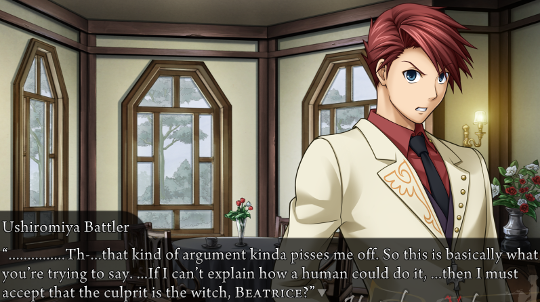
In response, Battler accuses them of arbitrarily privileging a particular hypothesis.
Kanon asks him to explain how his death doesn’t prove the existence of a 19th person. Battler argues in a way that dismisses what we saw of the scene - that Kumasawa could have done it - or that someone could have set a trap.
I don’t see why he’s ruling out a non-supernatural 19th person, playing the role of Beatrice?
Battler suggests that various characters - Kanon, Hideyoshi, Eva - were merely playing dead.
I think Battler could be doing a lot better here. Here’s my account of how a non-supernatural 19th person could have dunnit. We’ll call them Beatrice, since that’s the only name we have. And let’s give it a pretentious name too.
Provisional Mundane Beatrice Hypothesis
- Beatrice begins her preparations some time prior to the events of the story. She infiltrates the house, taking advantage of poor security, and creates a hole in the attic above Kinzo’s office, allowing her to observe Kinzo, and perhaps discretely take stationery from the office.
- Beatrice witnesses Kinzo throw the ring out the window. She goes outside and finds where it has fallen. She uses it to seal a letter in Kinzo’s stationery.
- Watching the house, Beatrice sees Maria has been left alone. She approaches Maria, identifies herself as Beatrice, and presents the letter.
- Beatrice lurks somewhere in the mansion, observing events unseen - perhaps there are hidden passages that only she knows about. She witnesses Natsuhi receive the charm from Jessica.
- That night, she starts the murders.
- She creates the illusion of golden butterflies for Shannon, perhaps by shining a torch with a butterfly cutout.
- At some point, she kills Shannon and maybe takes her keys.
- She enters the servants’ quarters, and threatens Gohda - maybe with a gun - to force him to bring poisoned refreshments to the guests. Or perhaps he does this of his own accord, and she poisons them discretely.
- Once the guests are poisoned, she threatens Gohda to make him help her hide the bodies. He tells her about the rose garden shed and gives her the keys. She either kills Gohda then, or forces him to help her carry the bodies to the shed and then kills him.
- She mutilates the bodies using the tools in the shed, locks the door, and paints the Seventh Pentagram of the Sun, most likely using a premade stencil.
- She returns to the house and breaks the radio and internal phone system.
- She scratches at Natsuhi’s door, and locks up the house, returns the keys to the servants’ quarters, then hides in her attic observation point.
- In the morning, she observes Kinzo discretely. While the others discover the first six bodies, she writes a letter to Kinzo, playing on his occult beliefs, and persuades him to leave the room and go the boiler room. Once he gets there, she uses some kind of weapon to ram a demonic stake and stuffs him in the incinerator.
- Beatrice observes the arguments in the parlour discretely from outside the room, or in a hidden space. When it becomes apparent that Eva and Hideyoshi are leaving, she hurries to their room and hides inside, probably under the bed.
- At some point, Hideyoshi goes to shower. Beatrice reveals herself, and uses some kind of power tool to ram a demonic stake into Eva’s head. Then she goes into the shower and kills Hideyoshi in the same way. She slides the ‘praise my name’ letter under the door and hides again.
- When Kanon and Genji leave to get bolt cutters, Beatrice quickly moves to the door and uses a stencil to paint the First Pentacle of the Moon on the door. Then she hides again.
- She waits under the bed while the chain is cut and the bodies are investigated. Once everyone leaves, she unlocks the door with a stolen master key, and exits the room (or alternatively leaves through a window, bypassing the people in the corridor). Smelling the burning body of Kinzo, she hurries to the boiler room, perhaps to hide the body better? If she doesn’t want Kinzo to be known to be dead?
- When Kanon enters the boiler room, she creates the illusion of golden butterflies (unless that’s narrative embellishment). He raises his axe to attack, but she stabs him with a Stake before he can hit her. She escapes into the courtyard, and from there back to the mansion.
- The remaining survivors retreat to the study, where she can observe but not attack them directly. She writes and seals a letter to encourage them to turn on each other, and drops it onto the pile of canned food. To her satisfaction, they make four members of the group leave the room.
- She enters the parlour using a master key - Maria only assumed she turned into butterflies, but did not directly see this.
- As Maria says, she announces her attention to kill three of the assembled group, and tells Maria to turn away and sing. Kumasawa probably does not put up much of a fight. Genji she perhaps persuades has a duty to be sacrificed. Nanjo she overpowers.
- She uses the stake-driver to put Stakes into the three of them, mutilates their faces, and writes a letter challenging Natsuhi to a duel.
- She leaves the room, locks the door, and repairs the phone. She rings the office and waits.
- She waits by the portrait and uses stage magic (or a helpful narrator) to create the illusion of forming out of butterflies. Then, she shoots Natsuhi with her own gun when Natsuhi comes to duel her. She hides by the portrait again.
- The kids assume Natsuhi committed suicide, but in fact her gun was never fired. The cartridge Battler ejects is a live round, not a spent one.
- We don’t know what happens in the epilogue, but it need not be a supernatural kidnapping. Beatrice either kills the cousins, or forces them to comply somehow.
I can’t say it’s likely, but I believe it’s consistent with the story presented, and makes no appeal to the supernatural.
Back to Battler
Battler argues that one of the ‘dead’ may have been faking, and responsible for murdering Kanon. He says fake death is a mystery novel cliché. He also says the doctor being an accomplice is a mystery novel cliché.
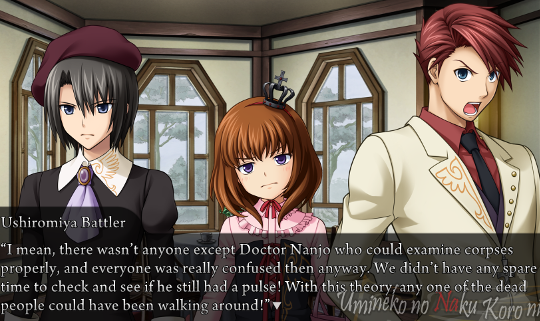
Battler suggests that while the first six were locked in a room, one of Eva or Hideyoshi might have faked the death and left via the window to race to the boiler room.
He insists, even if a 19th person existed, a witch should be a hypothesis of absolute last resort.
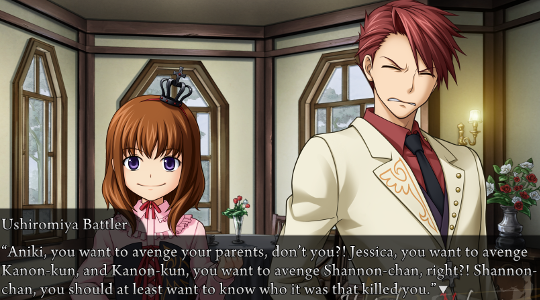
…are they the people who went through this experience or not? Now Battler’s talking about it as if they really are the people involved, not just observers of the story. But earlier…
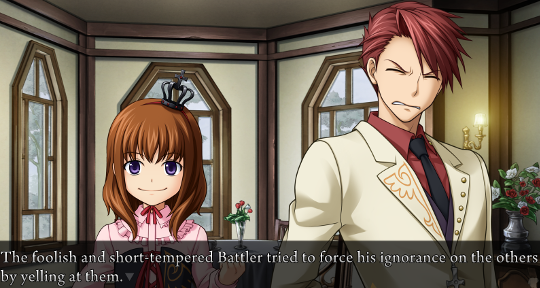
The narrator is definitely not neutral here. Maria is ‘wise’, Battler is a ‘stubborn child’.
Maria throws down the gauntlet for Battler ot provide a concrete mundane narrative.
Now they’re just asserting that Beatrice ‘exists’ (with quotation marks of course), or doesn’t.
Battler argues that not knowing how something works doesn’t mean you should write it off as ‘magic’, comparing not knowing how a lightbulb works. The point he’s dancing around: if you didn’t know about ‘electricity’, you wouldn’t have the information to understand a lightbulb. To understand lightbulbs, you’d have to start by coming up with a label for ‘whatever it is that makes lightbulbs work’ (or ‘whatever it is that makes amber stick to stuff’ historically) to help you start building a framework for understanding, such as ‘electricity’. That’s certainly not an explanation in itself. But you need to identify and delineate something as being outside your existing framework before you can start explaining it, and then you can connect that with other concepts and start to make senes of it.
Nowadays, we talk about ‘electrons’ with no question that they exist, but in the 1700s, ‘electrical fluid’ was a novel idea. Nowadays, ‘dark matter’ is similar.
‘Magic’ could be a catchall ‘it just does ok?’ non-explanation, but it could be a label for phenomena that you can’t yet explain but you’re going to. Battler’s objecting to the former, but I guess also suggesting the latter isn’t yet warranted.
Battler accuses them of trying to establish a false socially-constructed ‘truth’ that’s not actually true.
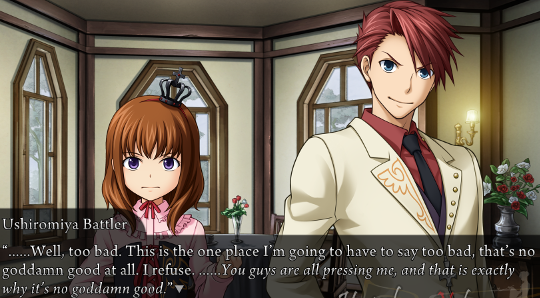
Once again it’s no good at all. Are we going to flip a chessboard now too?
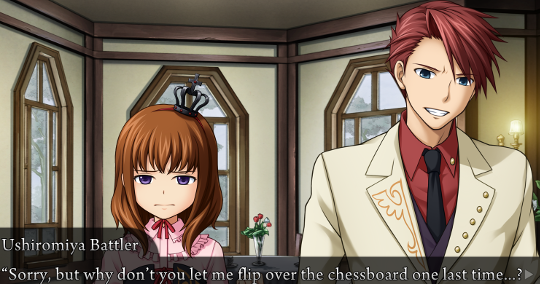
woooooo
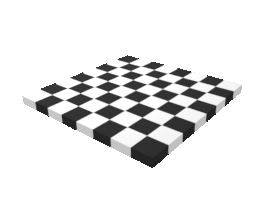
sick flips bro!
Battler demands they ‘actually show it to him’, how a witch did it with magic.
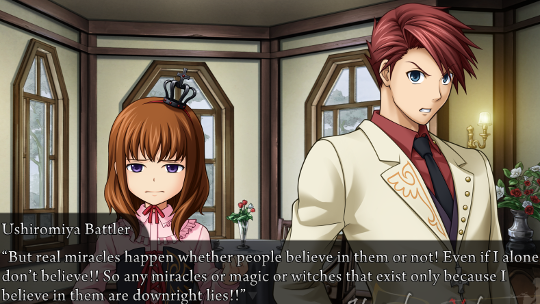
Battler’s overly dramatic obstinacy is hilarious, long may it continue.
Guess who shows up next (after more disparagement of Battler from the narrator)?
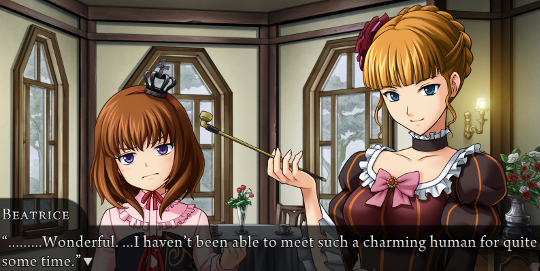
Well, well, well. Interestingly, this character portrait never appeared in the actual episode.
Beatrice, contrary to her reputation, finds it quite amusing that Battler doesn’t believe in her. She says it’s nice to meet a human with backbone once in a while over 1000 years.
Battler’s response: “Now this… this is some shit” omfg
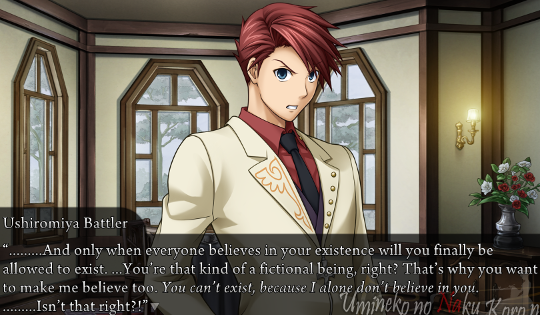
I’m really loving this right now.
Beatrice says he’s basically right, and he was born with ‘strong magic-resisting power’ making him ‘the natural enemy of us witches’. Magic ‘will always fall short against him’ because he will never believe in them.
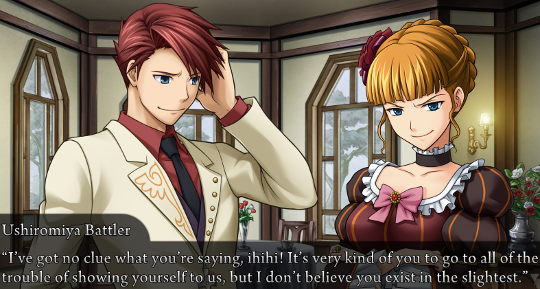
I’m just screenshotting all of Battler’s lines because they’re so good.
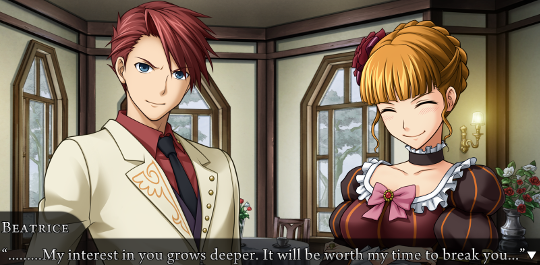
Beatrice accepts the challenge. She wants to make Battler praise her name and kiss her toes. Kinky.
Beatrice’s first challenge is to explain how he’d kill Eva and Hideyoshi through a crack in the door, as he claimed. She teleports them with a fancy screen wipe animation to the door of their room.
Battler can’t immediately think of a way to attack through the crack in the door, so Beatrice offers her method.
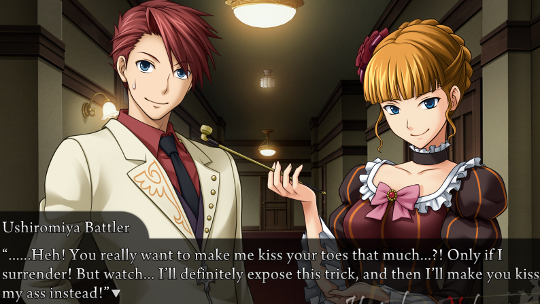
If this all leads up to them fucking….
Beatrice makes an incantation, summoning seven magic stakes.
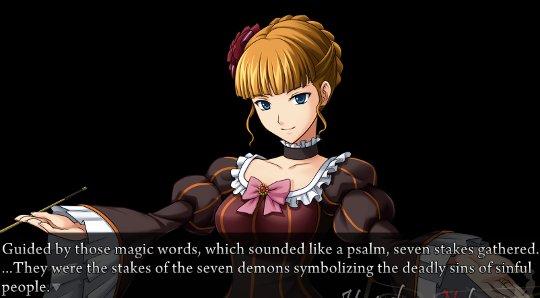
She sends the stakes of Beezlebub and Asmodeus into the room, and we get another ahaha.wav.
They return to the tea party, and Kanon has been killed again by Satan’s stake. the narrator calls this bad manners.
Beatrice declares that Kanon’s “deadly sin” was letting “trifling anger” interrupt her banquet. She really has it out for Kanon :(
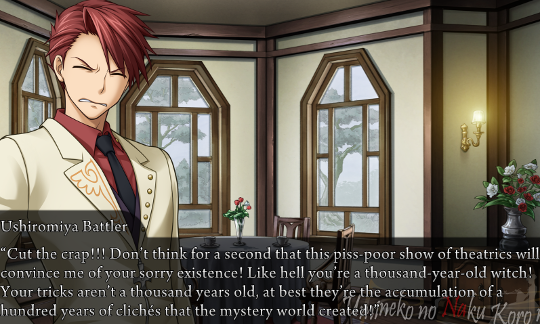
Battler remains deeply unimpressed.
Beatrice continues re-killing those assembled, injuring Shannon’s cheek in a way that expands to splitting her head open.
George says Battler’s refusal to believe is making the magic wear off. Then he dies too in a particularly (but nonspecifically) gruesome way.
The narrator continues saying rude things about Battler.
Jessica starts dying as well, but pleads with Battler to continue defying Beatrice.

Maria takes the ‘believe’ side as she starts dying.
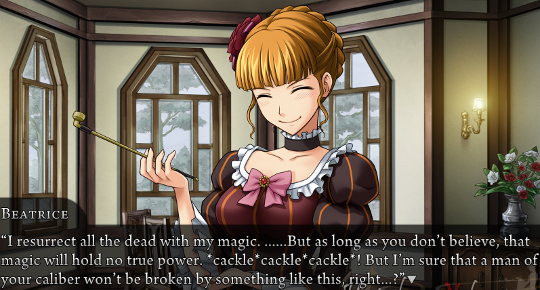
Beatrice confirms the narrative that her resurrection magic is wearing off. Jessica pleads to Battler not to give in unlike the others who didn’t want to distrust their friends, as she too gets gibbed.
Maria’s final words are that Beatrice will continue to resurrect them.
A new music track kicks in, replacing the baroque harpsichords playing throughout the tea party so far. Battler swears he won’t let this stand and Beatrice is on his “permanent motherfucking shitlist” (omfg)
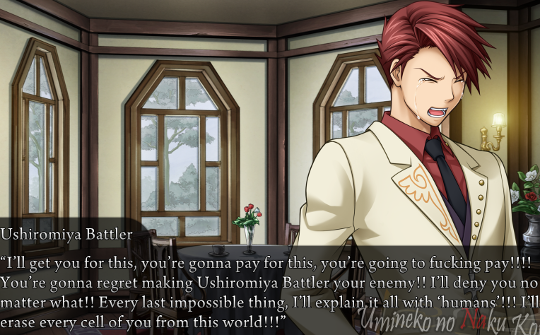
aaaaand… roll credits!

they’re kind of weirdly typeset.
Beatrice gets the last word.
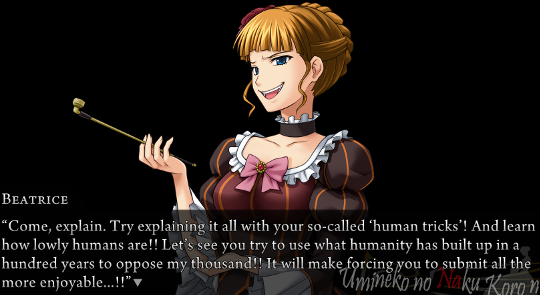
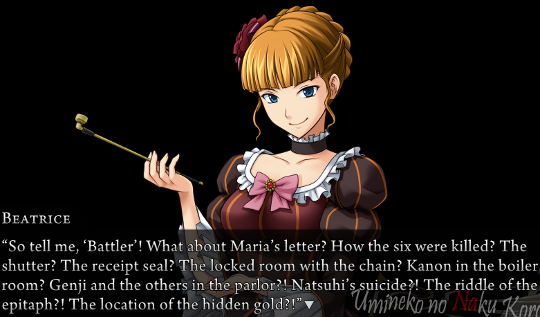
I was going to say ‘onwards to episode 2′ but a new menup option ????? has appeared, described as the ‘tea party of the unhuman’. So that will be our next post.
Comments